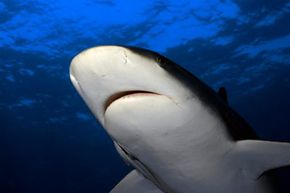Shark Senses: Smell
Smell is probably the most important shark sense, so much so that sharks have been referred to as "swimming noses" [source: SeaWorld]. There are some impressive statistics to back this up, too. A shark can sniff out fish extracts that make up only one part for every 10 billion parts [source: Elasmodiver]. Other research shows sharks are able to respond to one part blood for every one million parts of water; this is like being able to smell one teaspoon of something in a swimming pool [source: Shark Trust]. What's more, sharks can smell these small amounts from hundreds of meters away [source: SeaWorld].
How does the shark do this? Just under the snout are two nares, or nasal cavities. Each nare has two openings, one for water to enter and one for water to exit. The shark sucks or pulls the water into the nares to sniff out any evidence of prey. The water goes into nasal sacs and over a series of skin folds known as olfactory lamellae. The nasal cavities are big spaces, which gives the shark more time to register the smells. The nasal sacs are filled with sensory cells, which send signals to the shark's brain. The olfactory lobes in the shark's brain analyze the smells, looking for those that match the scent of their prey or the pheromones of potential mates. And sharks have pretty advanced equipment up there -- about two-thirds of the shark's brain weight is composed of olfactory lobes [source: Shark Trust].
Advertisement
Once the shark identifies the scent and decides to pursue, it starts swimming. The shark's natural swimming motion of moving its head back and forth provides further assistance in determining where the scent is coming from. With each movement, the snout picks up more water for the shark to analyze, and the shark is able to tell whether it's coming from the right or left nare. This helps them determine which way to swim.
The shark's nose may work so well because it doesn't have to do anything else. Sharks use their noses just for smelling. Breathing is accomplished with a shark's gills, and the shark's sense of smell is not connected to its mouth in any way. Sharks often don't know how something is going to taste until they've taken a bite. This is how some people are able to "escape" from a shark attack -- the shark gets a little nibble of a foot and decides to reject the prey.
Can sharks hear as well as they smell? Find out on the next page.
